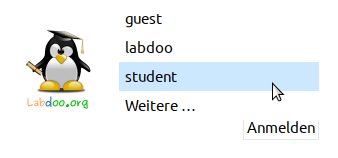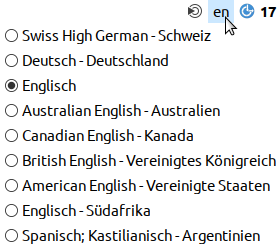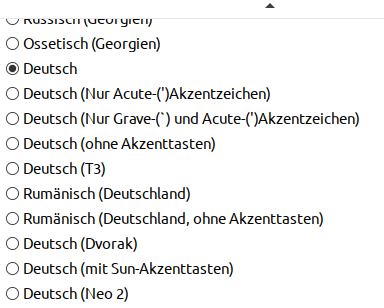Created users, user concept
Linux (Ubuntu, Linux Mint) is pre-installed on a Labdoo computer (release named xx.04 LTS, xx = 2020, 2022, 2024 etc.) and 3 users are usually set up:
student: is the standard user for all users / students. The ‘student’ user is not an administrator, i.e. they cannot accidentally destroy the system. The password is labdoo (each school / project can decide for itself whether to change this password)
guest: does not need a password; all his entries and changes are automatically deleted after logging out.
labdoo: this user is the administrator (‘super-user’). Without good IT knowledge, however, he can accidentally destroy the system! Therefore, only teachers and experienced users should know the password for the labdoo user. The password for the administrator is labdooadmin.
The characters of the password should be visible on the keyboard of the computer (Latin letters). If the password consists of non-Latin characters, there is a risk that you will not be able to log in.
Important: The keyboard layout can be changed manually at the time of logging in (see below). The system setting of the keyboard layout is changed via the system file /etc/default/keyboard. Labdoo recommends storing the keyboard layout of the delivered computer in this system file (WYSIWYG).
| User log in, select user |
|
| Select a user language (after log in) |
|
| Select a keyboard layout |
|
| Settings for visually impaired users (optional |
|
Important: the keyboard layout used when logging in will be set during the installation process of (L)Ubuntu. If you installed a computer using images for cloning this will be the German keyboard (DE). Otherwise, the keyboard layout used to install Ubuntu will be the one to remain. To change the layout after logging in, open a terminal (press Strg/CTL + Alt + T at the same time) and type sudo nano /etc/default/keyboard (press Enter). Next, change the keyboard code, (e.g., EN for English, FR for French, ES for Spanish etc.). You can optionally add the code of a specific country in the following line between the 2 quotation marks (z.B. CH for Switzerland). Then store the file (Strg/CTL + Alt + O (Enter), next Strg/CTL + Alt + X). You will NOT modify the keyboard layout you have used after having already logged in. This can be changed using the setting or the keyboard layout icon in the task bar.
Desktop MATE
| The recommended desktop is the MATE Desktop. |
The computer remembers the last desktop used by each user. If you want to change the desktop (user interface), you must do this when logging in.
To change the password → Go to system settings → user accounts → unlock →
Password ‘labdoo’ → click on Password, change it, click on labdoo User → select Standard ←→ Administrator, depending on which rights are required.
Starting programmes
Start one of the learning / game programmes. There are fun ones and learning ones. How to start them:
Click on MATE at the bottom left → ‘Education’ or ‘game’ → click on the programme
In the ‘/Public’ folder, you will find useful manuals, licence-free learning content (OER), offline wikis, e-books, etc.
You will find a ‘Videos’ folder on the desktop. Click on it and you will find videos explaining the Labdoo laptop. Language, regional formats and keyboard settings Sometimes you want to reinstall or change one or more languages. Click Preferences → on Language Support (Language). If the message ‘Language support not completely installed’ appears, confirm with Yes and install (an internet connection is required). In the next window, click Install/Remove languages → select the language(s) you need→ Apply → Apply System-wide. | 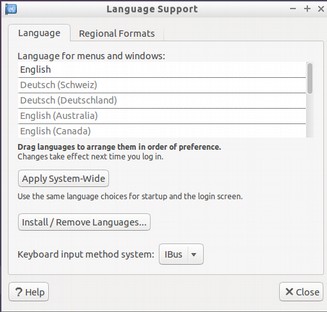 |
The new language(s) appear in a list: Lubuntu uses the languages from top to bottom, i.e. if a word is not translated in the 1st language, language 2 comes next and so on up to English. Search for the new language, click on it, hold down the left mouse button and drag it to the top position, release the mouse button → click on Apply System-wide. The new language appears after a log-out or restart. Regional formats You can also set the regional formats for numbers, currency, date, etc. To do this, click on the ‘Regional formats’ tab and click on the country of your choice in the list → Apply System-Wide. | 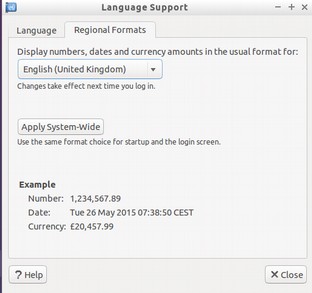 |
Keyboard settings Right mouse click in the task bar on the ‘DE’ (or US etc.) symbol or on the flag symbol → Keyboard Layout handler Settings (keyboard layout) → Remove the ‘Keep system layout’ tick, if still set → +Add → Add a new keyboard layout A maximum of 4 keyboard layouts can be selected. | 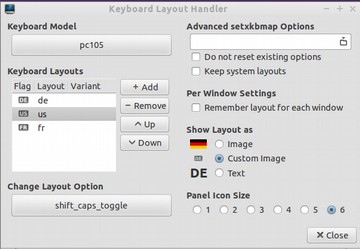 |
Manuals, video tutorials Manuals, video tutorials, offline wikis and much more can be found in the /home/labdoo/Public/ folder. The ‘videos’ icon on the desktop takes you directly to the folder with the video tutorials. A video can be viewed in Firefox or a player (zoom +/- if necessary). |  |
Installing codecs for multimedia, films and DVDs
You will find the script installscript-codecs.sh on the desktop. Please only run this script if you are sure that the laws and regulations in the country where the computer is used permit this. Patent and copyright protection work differently depending on the country. Please seek legal advice if you are not sure whether legal restrictions apply to media formats (codecs) in your country.
However, you will not be able to view certain multimedia data, videos or DVDs without executing this script. This script installs additional software and codecs for multimedia applications. Please only run this script if the legal requirements are met. The computer must be connected to the Internet. Alternatively, you can also purchase commercial multimedia software, e.g. ONEPLAY DVD Player (https://wiki.ubuntuusers.de/ONEPLAY_DVD_Player/) or LinDVD (https://wiki.ubuntuusers.de/LinDVD/).
Further information on this topic can be found at https://wiki.ubuntuusers.de/Codecs/.
Programmes for blind or visually impaired users
There is a Magnifier icon on the desktop; click on it to open a magnifying glass that can be moved with the mouse. An icon for the magnifier also appears in the panel. Right-click on it to open numerous setting options.
Other programmes for disabled users are:
| Program | Descriptions | Program name | Screenshot |
| Orca | To turn Orca on or off, press <strong>Alt + Super/Windows + o</strong> simultaneously. To configure, open Terminal (as user labdoo, press Ctl/Ctrl + Alt + t simultaneously), then type <code>orca -s</code> and press Enter. | Orca |  |
| pico2wave | File reading tool, more information at https://wiki.ubuntuusers.de/Sprachausgabe/ ; to turn pico2wave on or off, press <strong>Alt + Super/Windows + p</strong> simultaneously. Highlight text, then press the above key combination; the text will be read aloud. The highlighted text must not be too long, otherwise, the program will abort with an error message. | pico2wave |
More information on solutions for handicapped users can be found here https://www.labdoo.org/content/programs-handicapped-users-barrier-free.
Set volume
In the panel you will find an icon to mute or turn the volume up or down. Clicking on that icon will open a dialogue (mute, volume up or volume down). But there are much more settings for volume, microphone etc., which can only be accessed by a program called alsamixer:
| Program | Descriptions | Program name | Screenshot |
| alsamixer | The program alsamixer is a tool to access all ALSA settings provided for the sound card. Frequent settings, which cannot be directly accessed with the X-user interface, are deactivated or down-regulated. With Alsamixer you can quickly find and activate these settings. Open a terminal (press Ctl/Strg + Alt + t at the same time), type alsamixer (enter). Now you can adjust the volume settings, move the keys ← → to move to the next channel, ↑ ↓ to turn the volume up or down. | alsamixer | 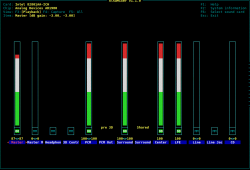 |
Printer settings, CUPS
A printer can be added and administrated by clicking System Tools → Printers → + Add a printer. Most printers, as far as they are connected to the computer or to network (LAN), will be recognized automatically.
For a more complex solution there is Cups (Common Unix Printing System), the most common print tool for Linux. Most printers can be used, jobs and spools administrated using CUPS. CUPS comes with an integrated web server. This server can be used to set up and manage a printer. Open a web browser and open: http://localhost:631. Only the user labdoo is allowed to access this page. In case a printer is locally connected to a computer you can allow access for another computer to this printer via LAN.
Help function F1, manual
By pressing the key F1 or help in the menu bar most programs will open a window and a manual for this program will show up.
Reset and restore user student
A student should log in as guest or as user student, but never as user labdoo (only teachers, administrators should use it). But even if you log in as user student, some menu bars or icons might be deleted by mistake. Everything can be "repaired", but you have to know how - and this knowledge might be missing at schools. But we offer a good solution for that - on the labdoo user's desktop you will find a script restore_user_student.sh (Double click to start the script, run in a terminal). But be careful! This script will delete every(!) data / document stored or reset every setting configurated since you received the laptop! So, make sure all data needed is assured! Sometimes this script is also helpful if you want to remove all of the data before giving the computer to another user.
Log in as administrator labdoo
labdoo: is administrator (admin, "Super User")! This means that the user labdoo has all access rights, e.g., for updating, installing additional software and educational content etc. But as the admin you can accidentally "destroy" the laptop so that it does not start and can no longer be used, especially when users have none or poor experience with IT and Linux. And if the computer is "destroyed", the closest Labdoo hubs who can help with a reinstallation or give support are far away. That could become a real problem.
Therefore, sign up only as user labdoo, if you act carefully and already have experience with the administration of computers. Otherwise, it is better to log in as user student, who has not the administrator rights, but can also use all programs and content - and has less chances to destroy a computer by mistake.
The password to log in is at delivery labdoo (for all systems being delivered with Ubuntu 18.04 LTS or former releases, until about spring 2020). From Ubuntu 20.04 LTS ff. (starting about summer 2020) the password will change to labdooadmin. However, you should change this password immediately once you receive the computer at your school / project, because the user labdoo has administrator rights and only the teachers / maintainers and experienced users should have access as admins!
Have fun learning and playing with your Labdoo laptop!
The Labdoo team
